❑Closing a Month means that you are telling MKMS to no longer accept Financial Transactions - whether they be additions, changes, and/or corrections - within the Accounts Receivable System that are dated on or before the month closing date (which is automatically set as the last day of that month).
a.It is a good business accounting practice to close a month soon after it has ended, from 15 - 30 days at the most, from the end of that month.
b.Because you still will have access to the Bounced Checks and Credit Memos processes, any Financial Transactions that must be reversed at a later time are easily done with these two available methods, so there is really no reason not to close a month.
c.Closing a Month will also prevent anyone from accidentally entering the wrong transaction (i.e., old) date.
d.The problem that could occur is: when months are not closed, a User could go back and make a (fraudulent) entry that you might never see - providing an easy avenue for embezzlement.
e.Closing a Month is the only Accounts Receivable System control available (when the General Ledger System is not is use) that will prevent someone from accidentally (or deliberately) using the wrong (old) date when entering a Financial Transaction (e.g., Sale, Receipt, Credit Memo, Refund) in the Accounts Receivable System.
•At least one Employee must be authorized to view a Accounting Administrator
✓The Accounting Administrator authority is granted to a User by Checking the Accounting Administrator? box in the Security tab of the Employee Form
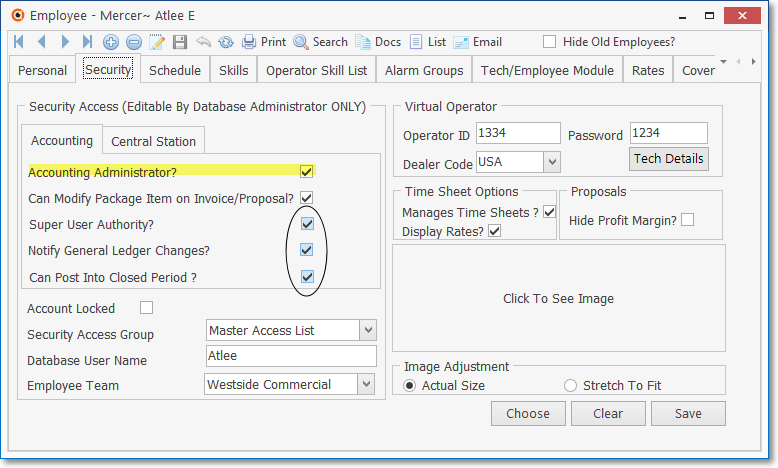
Employee Form - Security tab - Super User, Notify General Ledger Changes, Can Post Into Closed Period Check boxes
✓In that Security tab of the Employee Form, that User may (and often will):
a)Be identified as an Accounting Administrator by Checking the Accounting Administrator? box .
b)Be classified as a Super User by Checking the Super User Authority? box.
c)Be Notified of General Ledger Changes by Checking the Notify General Ledger Changes? box (only available when the General Ledger System has been activated).
d)Be permitted to Post into a Closed Period by Checking the Can Post Into Closed Period? box.
❑About the Month Closing Process as it relates to General Ledger System Users (When the General Ledger System has, or has not been Registered but the GL Start-up Wizard has not been completed):
1.This Accounts Receivable System - Month Closing Process must be used when the General Ledger System is not active (i.e., the General Ledger Setup Wizard has not been successfully executed).
2.When the General Ledger System is active, this Month Close menu option will not be listed.
a.Instead, Closing an Accounting Period (a specified Month) in the General Ledger System will also Close that Month in the Accounts Receivable System
b.This will also prevent Financial Transactions from being entered with a posting Date prior to a General Ledger Closed Accounting Period in all other financially oriented modules (i.e., Accounts Receivable, Accounts Payable, Inventory Tracking).
❑Your End of Month Procedures - The steps outlined below cover what normally should be done when an Accounting Period has been completed in the Accounts Receivable System.
•This closing procedure should be executed shortly after the month actually ends (certainly within 15 days or so) to help prevent Financial Transactions from being accidentally posted to the wrong month (i.e., Accounting Period).
✓When you "close a specified month" you are locking that month (Accounting Period) - freezing it results - so the data on the reports covering the Financial Transactions that occurred within that Accounting Period will forever remain the same, regardless of when they are (re-)printed in the future.
✓If you didn't close a month, the reports for that Accounting Period could be ever-changing documents, because there would be no restrictions on entering new Financial Transactions for that month (Accounting Period) in the future.
•Generally, the reports listed here should be reviewed for accuracy when a month is closed (special care must be taken to specify the correct Date Range for these reports):
✓Preview and/or Print a Monthly Cash Receipts Report - Once all of the Receipts are posted for the completed month, print the Monthly Cash Receipts Report by selecting Specific Dates (the first through the last day of the month you are closing - or have just closed).
✓Preview and/or Print a Sales Analysis Report - Once all of the Sales are entered for the completed month, print the Sales Analysis Report for the month to be closed.
✓Preview and/or Print the Credits Issued Report - Once all of the Credit Memos are entered for the completed month, print the Credits Issued Report for the month being closed.
✓Preview and/or Print the Accounts Receivable Report as of that month ending date - Once all the Sales and Receipts are entered for that Accounting Period.
•Calculate Sales Taxes (This may be the responsibility of the Accounts Payable Department) - Prepare for your Company's Sales Tax Reporting and Payment requirements.
•Print your Recurring Revenue related Reports to get a clear picture of how your Company is doing with that segment of the business.
✓Preview and/or Print an Attrition Report - To take a look at the state of your Company's recurring revenue stream, print this report.
✓Preview and/or Print an Average Recurring Revenue report which is used for tracking your Company's Recurring Revenues over time to see whether the Recurring Revenue base is expanding or contracting.
✓Preview and/or Print an Expiring Contracts Report because it is up to you to contact the Subscriber to Renew their Contract(s) by using the Expiring Contracts Report to identify those Subscribers who need to be renewed.
✓Preview and/or Print a Recurring Revenue Breakdown report to review your Company's Recurring Revenues based on Departments and/or Billing Frequency will allow you to better manage each of these profit areas more effectively.
✓See the Recurring Revenue & Other Revenue Related Reports chapter to determine what other Recurring Revenue related reports would be useful for your Company.
•Finally, complete the closing of the Accounts Receivable System by executing the Month Closing procedure (see below).
❑The Month Closing procedure should be performed soon after the month has ended using this Month Closing dialog, or by Closing this Accounting Period (a specified Month) in the General Ledger System.
•To open the Month Closing dialog:
a)From the Backstage Menu System Select File and Choose Receivable and Select the Month Close option, or
b)From the Quick Access Menu, Select File and Choose Receivable and Select the Month Close option
✓The Period Close dialog will be presented.
•When the General Ledger System is not active, the Period Close dialog will appear and function as illustrated and described below:
❖Also see the "When the General Ledger System is active" discussion at the end of this chapter.
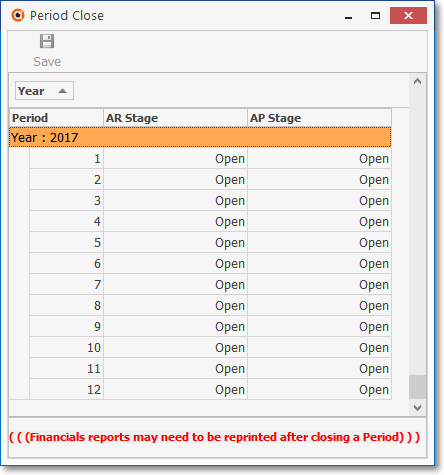
This Period Close dialog is only be available if the General Ledger is not Active
✓AR Stage - Locate the Period Number to be Closed
▪Use the Drop-Down Selection List to Choose the AR Stage which is to be set.
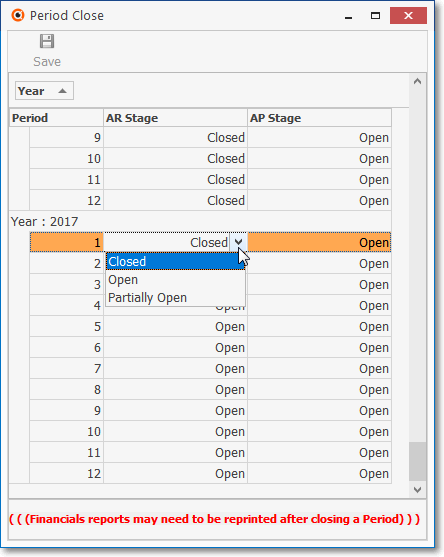
Period Close dialog - AR Stage options
a.Closed - This Closing Stage restricts all posting to and from all modules
▪This Stage may be changed to Partially Closed, or Open, if necessary; or remain as Closed.
b.Open - This is the default Closing Stage and allows posting to and from all modules.
c.Partially Closed - This Closing Stage temporarily restricts all posting to and from all modules.
▪This Stage may be changed back to Closed, or Open, if necessary.
➢Note: When closing a month for the first time, you will have to step through this process many times until you get to the month you actually want to close.
You may contact Tech Support and ask them to modify the Last Closed Date (within MKMS) to match the Date that was Closed in the previously used software.
Thereafter, MKMS will present the correct month to be closed next.
• Click the ![]() Icon to identify this Period as Closed.
Icon to identify this Period as Closed.

✓When the process is completed (it only takes a second or two), you will be asked if you want to Generate Late Fee Invoices.
✓If you have not yet done so for this Closed Date, answer Yes to the Late Fee Generation question, otherwise, answer No.
•If Yes was your answer, The Late Fee Invoice Generation dialog will open.

✓See the Run Late Fee Invoice Generation chapter for more information.
✓You are finished Closing The Month in AR.
•Thereafter, if attempting to make an entry in the Accounts Receivable System dated within a Closed Period, an Information message will be displayed reminding you that the Accounting Period is Closed.;
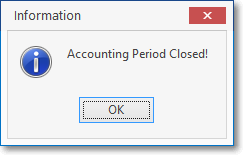
Accounting Period Closed!
❑When the General Ledger System is active, the Period Close dialog will appear and function as illustrated and described below:
•Period To Close - Locate the Period Number to be Closed
•Stage - Select the AR Close option.
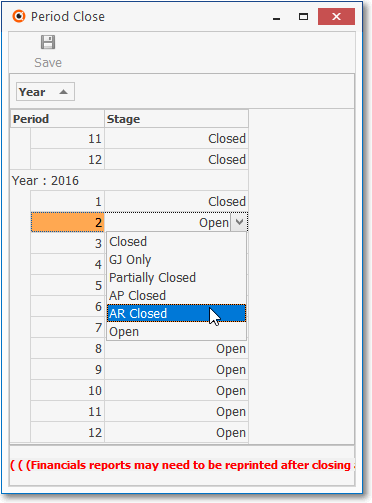
Period Close dialog - available when the General Ledger is Active
•Save - Click the ![]() Icon to identify this Period as Closed.
Icon to identify this Period as Closed.
•Run Late Fee Invoice Generation - This step must be performed manually.